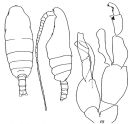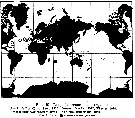|
|
 |
Fiche d'espèce de Copépode |
|
|
Calanoida ( Ordre ) |
|
|
|
Clausocalanoidea ( Superfamille ) |
|
|
|
Aetideidae ( Famille ) |
|
|
|
Pseudochirella ( Genre ) |
|
|
| |
Pseudochirella major (Sars, 1907) (F,M) | |
| | | | | | | Syn.: | Bradyetes major Sars, 1907 a (p.9, Rem.F);
Pseudochirella fallax : Sars, 1920 c (p.6, Rem.); 1925 (p.95, figs.F, Rem.M); Grice & Hulsemann, 1965 (p.223); Deevey & Brooks, 1977 (p.256, tab.2, Station "S"); Bradford & Jillett, 1980 (p.66); Markhaseva, 1989 (p.35, 40, 41, Descr.M, figs. M); 1996 (p.264, figs.F,M) | | | | Ref.: | | | Vaupel Klein, 1995 (p.914, Rem.) |  issued from : E.L. Markhaseva in proc. Zool. Inst. RAN, St. Petersburg, 1996, 268. [p.265, Fig.210]. As Pseudochirella fallax. Female (19°09'S, 63°07'E)). Ce: forehead; P.md: mandibular palp; Gntb Md: gnathobase of Md (partial); CP4: coxopod of fourth leg. Nota: Cephalothorax 4.0-4.6 times longer than urosome. Rostrum developed weaker than in other species of genus. Posterior corners of last thoracic segment slightly asymmetrical (dorsal view), prolonged into rounded lobes. Genital segment slightly asymmetrical; lateral swelling on the left more prominent than on the right; genital field removed laterally (ventral view). Urosomal segments 1-3 surface with hairs. A1 about as long as body. Exopodite of P1 3-segmented. Endopodite of P2 2-segmented. Coxopodite of P4 with 20-23 spines (14 spines recorded by Sars, 1925).
|
 issued from : E.L. Markhaseva in Proc. Zool. Inst. RAN, St. Petersburg, 1996, 268. [p.266, Fig.211]. As Pseudochirella fallax. Male (from Markhaseva, 1989). Nota: Cephalothorax about 3.6 times longer than urosome. Posterior corners of last thoracic segment without spines, slightly asymmetrical (dorsal view). A1 longer than body by 2-3 last segments. Oral parts reduced in comparison with those in females. Exopodite of P1 3-segmented, but 1 external spine significantly shorter than in female. Endopodite of P2 2-segmented. Coxopodite of P4 without spines and setae. Exopodal segment 2 of left P5 with 1 tooth, exopodal segment 3 nearly 4 times longer than wide.
|
 Issued from : G.O. Sars in Résult. Camp. Scient. Prince Albert I, 69, pls.1-127 (1924). [Pl.XXVI, figs.5-9]. As Pseudochirella fallax. Female: 5, habitus (dorsal); 6, idem (lateral left side); 7, forehead (showing the labrum), lateral; 8, frontal view; 9, basal segment of P4.
|
 Issued from : E.L. Markhaseva in USSR Acad. Sci., Zool. Inst., Explor. Fauna Seas. Marine Plankton, 1989, 41 (49).< [p.53, Fig.27]. Female off Azores Is.): Thoracic segment 5 and genital segment. Nota from the key: 1 - Genital segment strongly asymmetrical. 2 - Both left and right thoracic posterior corners without spines. 3 - Thoracic posterior corners with rounded lobes. 4 -Thoracic posterior corners slightly asymmetrical. 5 - Genital field present in the middle part of genital segment (ventral view). 6 - Third internal lobe of Mx1 with 5 setae. 7 - Genital segment with protuberance on both right and left sides. 8 - Gnathobase posterior surface of Mx1 with 4 setae.
| | | | | Ref. compl.: | | | Sewell, 1948 (p.500) | | | | NZ: | 3 | | |
|
Carte de distribution de Pseudochirella major par zones géographiques
|
| | | | | |  Issued from : E.L. Markhaseva in Issled. Fauny Morei, 1989, 41 (49). [p.60, Fig.19]. Issued from : E.L. Markhaseva in Issled. Fauny Morei, 1989, 41 (49). [p.60, Fig.19].
Geographical distribution of P. fallax [= P. major].
2: from literature; dotted circle for Grice, Hulsemann, 1965; 3: present occurrence. |
| | | | Loc: | | | Atlant. (temperate), Azores, Caribbean, Sargasso Sea: off Bermuda: Station "S" (32°10'N, 64°30'W), SW Indian (off Rodrigues Is.)
Type locality: North Atlantic (central part). | | | | N: | 6 | | | | Lg.: | | | (1) F: 3,8; (37) F: 3,8-3,6; M: 3,2; {F: 3,60-3,80; M: 3,20} | | | | Rem.: | bathypélagique.
Après une analyse historique des changements du nom de genre et d'espèce de cette forme par Sars (1907, 1920 et 1925), Vaupel Klein (1995, p.914-916) conclut, conformément aux règles de la Commission Internationale de Nomenclature Zooplogique, à la dénomination de Pseudochirella major comme valable.
Sars (1925, p.96) note que cette forme fut d'abord par erreur référée au genre Bradyetes Farran, à cause de l'apparent défaut du rostre. Par un nouvel examen l'auteur a constaté un rudiment minuscule de rostre. | | | Dernière mise à jour : 30/01/2015 | |
|
|
 Toute utilisation de ce site pour une publication sera mentionnée avec la référence suivante : Toute utilisation de ce site pour une publication sera mentionnée avec la référence suivante :
Razouls C., Desreumaux N., Kouwenberg J. et de Bovée F., 2005-2025. - Biodiversité des Copépodes planctoniques marins (morphologie, répartition géographique et données biologiques). Sorbonne Université, CNRS. Disponible sur http://copepodes.obs-banyuls.fr [Accédé le 21 octobre 2025] © copyright 2005-2025 Sorbonne Université, CNRS
|
|
 |
 |







